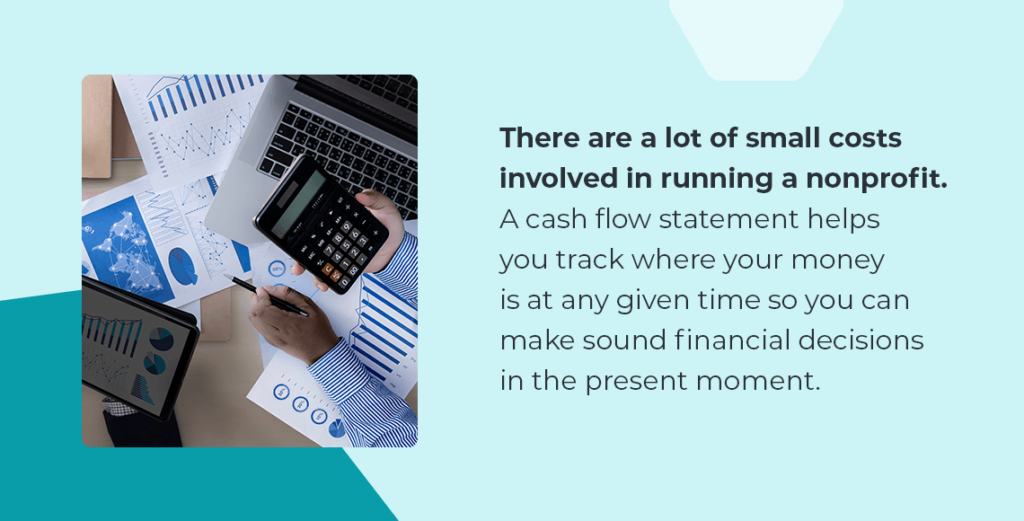Reading Time: 5 minutes
Your nonprofit financial statements keep donors informed about where money is going and how it’s being divided between different categories. There are four financial statements for nonprofits to use to track finances:
- Balance sheet
- Statement of activities
- Cash flow statement
- Functional expense report
In this post, we go over each financial statement, review its primary purpose and suggest areas of improvement. Unlike for-profit organizations, your statements don’t need to focus on how much money you’ve made. Rather, the goal is to be transparent for donors and regulatory bodies, and to demonstrate that you’re managing all funds responsibly.
Balance Sheet
Another name for this financial report is “statement of financial position.” The balance sheet for your nonprofit organization shows the relationship between its assets and liabilities — or, the amount that your nonprofit owns compared to what it owes.
By keeping track of the balance between your organization’s assets and liabilities, you’re equipped to make good financial decisions for your organization’s future. Let’s look more specifically at each category.
A nonprofit organization’s assets may include cash, property and investments. By contrast, nonprofit liabilities include any type of financial obligation, such as credit cards, mortgages or other loans.
For a nonprofit’s balance sheet to balance, its assets must be equal to its liabilities plus net assets. Net assets vary from assets because they represent what’s left after you subtract an organization’s liabilities from its assets.
Your nonprofit’s balance sheet must continually be updated so it accurately represents your organization’s financial health at any given point in time. Comparing current and past balance sheets can show you how healthy and stable your nonprofit’s finances are.
The most important thing you can do to improve your nonprofit’s balance sheets is to ensure they’re accurate and updated at all times. Accuracy leads to transparency, which is what donors are looking for when they work with a nonprofit. Transparency builds trust and can lead to an expanded donor base and more opportunities for your organization’s future.
If you’re struggling to keep up with your organization’s balance sheets, it may be time to consider a new approach. Updating your method of recording finances can reduce stress and empower your organization to be more clear and transparent.
Statement of Activities
Another important financial document, a nonprofit’s statement of activities shows a summary of an organization’s expenses and revenue, typically over a fiscal year. This financial statement gives an overview of a nonprofit’s finances so all its financial activities are easy to understand.
Let’s look more closely at the details included in a nonprofit statement of activities. First, there will be records of anything considered revenue and generates income for the nonprofit. These are typically grants, donations and other fundraisers.
In addition to revenue, nonprofit organizations also have expenses for their programs, fundraising efforts and administration.
Any money spent to support the nonprofit should be listed in the statement of activities. Like the balance sheet, this statement also has a net number, known as net income/loss. This number compares total revenue and total expenses to show whether the organization has net income or loss for that period.
In addition to comparing total revenue and expenses, a statement of activities keeps the nonprofit’s mission at the forefront of the report. Keeping track of revenue and expenses allows donors and stakeholders to see how their finances impact the organization’s mission.
To make the most of this document, it’s important to understand variance. There is often a difference between a budget and actual expenses. Keeping careful track allows you to plan more effectively for next year. Another factor to consider is donor restrictions — some donations are expressly reserved for certain purposes. Your nonprofit’s statement of activities can help you proactively plan and manage restricted donations.
Cash Flow Statement
The third financial statement you need for a nonprofit is the cash flow statement. This details the cash coming in and out of your nonprofit during a specific period. In this statement, you’ll include information about where cash is coming from and what your organization is using it for.

There are a lot of small costs involved in running a nonprofit. A cash flow statement helps you track where your money is at any given time so you can make sound financial decisions in the present moment.
It helps you know how much cash is currently available and equips you to budget more strategically. One aspect of a cash flow statement that’s especially important is the comparison it allows between accrual basis and cash basis.
Accrual Basis vs. Cash Basis
Accrued expenses are delayed — although they’ve already been committed to, they’re actually paid during a separate accounting period. Similarly, accrued income is entered when it’s earned, such as when you receive notice you’ve been awarded a grant, rather than when the funds actually come in. Because of the time difference, they’re more difficult to track. By contrast, cash basis shows when money actually changes position — it doesn’t account for income or expenses until the actual time funds move from one account to another.
When you accurately track cash in your nonprofit’s cash flow statement, you can compare those numbers with the accrued expenses recorded in your organization’s balance sheet and statement of activities. This can help you understand liquidity, or how much money is free to be moved at a given time.
Again, your cash flow statement will be easier to record and compare with other records if you use a system that’s simple, reliable and easy to update. If you can find an updated software program that includes all of these forms, it will be much easier to use them to improve your organization’s financial health.
Functional Expense Report
The fourth financial statement you should have as a nonprofit is a functional expense report. This report divides expenses by function, so you can easily see what areas are getting the most funding and what items are being supported by specific donor funds.
A few examples of function categories include:
- Fundraising
- Administration
- Building upkeep
- Nonprofit services
- Community outreach
By keeping track of what function finances are supporting, this report strengthens the relationship with donors and helps you strategically budget for the next period. Dividing by function is an easy way to explain financial decisions and show the practical impact of all nonprofit funding.
Functional expense reports are incredibly useful for your organization because they allow you to benchmark your spending with that of other, similar organizations. By comparing cost ratios, you can find opportunities to save and areas to spend more. Benchmarking lets you know how reasonable your costs are in each category.
This report is also valuable for demonstrating compliance with regulations. It helps you meet legal requirements, build trust with donors and reassess your financial goals for the following period. Alongside the other three reports mentioned, functional expense reports help to give a complete picture of your nonprofit’s finances.
Improve Your Nonprofit Records With MIP Accounting

At MIP Accounting, we offer a cloud-based, SAAS fund accounting software that’s ideal for nonprofits, schools and government entities. Our goal is to make accounting easy for your organization, so you can focus on making good decisions for your nonprofit’s future.
Our program is easy to use and pulls all your information together so it’s accessible in one place. We have over 30 years of experience working with nonprofits and designed our software to support your accounting processes. Our program can even help to strengthen your organization’s audit compliance.
When you work with MIP Accounting, you’ll save time, money and stress. Your employees will love the new system — its organization, automation and other capabilities can make their jobs significantly easier. Request a free demo today to learn more!




